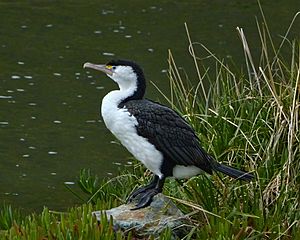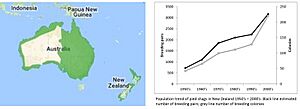Australian pied cormorant facts for kids
Quick facts for kids Australian pied cormorant |
|
|---|---|
 |
|
| In New Zealand | |
| Conservation status | |
| Scientific classification | |
| Genus: |
Phalacrocorax
|
| Species: |
varius
|
The Australian pied cormorant (Phalacrocorax varius) is a medium-sized bird from the cormorant family. You might also hear it called the pied cormorant, pied shag, or great pied cormorant. These birds live around the coasts of Australasia, which includes Australia and New Zealand. In New Zealand, people often call it the pied shag or by its Māori name, kāruhiruhi.
Contents
What Does It Look Like?
The pied cormorant has a mostly black back and upper wings. Its underside is white. Male birds weigh about 2.2 kilograms (4.8 pounds), and females weigh around 1.7 kilograms (3.7 pounds). They stand between 65–85 centimeters (25–33 inches) tall. Their wingspan can reach 110–130 centimeters (43–51 inches).
You might notice a small yellow patch between its bill and eye. This is probably why it was once called the "yellow-faced cormorant." This bird has large webbed feet, which it uses to chase fish underwater. It steers itself with its half-opened wings. It also has a big hooked bill, green eyes with a blue ring around them, and black legs and feet. Its eyes have a special clear eyelid, called a nictitating membrane, which protects them underwater.
After diving, the pied cormorant often spreads its wings. This helps dry its feathers because they aren't fully waterproof. This lack of waterproofing might actually help the bird stay underwater longer. It makes them less floaty!
There are two types of pied cormorants. One lives in New Zealand (Phalacrocorax varius varius), and the other in Australia (Phalacrocorax varius hypoleucus). They have small differences in how they look. Other similar birds include the black-faced cormorant (which is a bit smaller) and the little pied cormorant (much smaller).
Where Do They Live and Are They Safe?
The pied cormorant is listed as "least concern" on the IUCN Red List of Threatened Species. This means it has a large range and its population is quite stable.
In New Zealand, you can find them along the east coast, as far south as Christchurch. This is a new area for them; older books said they didn't go further south than Kaikoura. Their numbers have grown since the early 1900s, when many were hunted. The pied cormorant is listed as "Nationally Vulnerable" in New Zealand. Their population has increased from about 700 breeding pairs in the 1950s to an estimated 3,000 pairs after the year 2000.
In Australia, they are quite common in the eastern states, both on the coast and in wetlands inland. They are very common in the south-west, especially along the coast. Their conservation status in Australia is "secure," meaning they are not at risk. However, in Victoria, they are listed as "near threatened." You can find them in all Australian states except Tasmania.
Pied cormorants face some risk from fishing, especially from nets. Sometimes, birds in colonies get tangled in fishing lines with hooks. In the past, people saw them as competition for fish and sometimes shot them.
What Is Their Home Like?
Pied cormorants usually live near the sea. You might see them alone, in pairs, or in huge groups of hundreds or thousands. But they also like inland waters, such as lakes, deep wetlands, and rivers. In Australia, they are often found in inland waterways. In New Zealand, they prefer coastal areas where their food is close by.
Adult birds tend to stay in one place. You can often see them resting in trees, on rocks, or on logs in the water. They don't seem bothered by different levels of saltiness in the water, how clear the water is, or what plants are along the shore, as long as there are places for them to perch.
How They Live
What They Eat
The pied cormorant mainly eats fish that live on the bottom of the water (called benthic fish). These fish are usually 6–15 centimeters (2–6 inches) long and found in waters less than 10 meters (33 feet) deep. Young King George Whiting are one type of fish they eat. About 10% of their diet includes crustaceans like prawns and shrimp, and some molluscs (like snails) and cephalopods (like squid).
They dive for food in both shallow, calm water and fast-moving currents. A typical dive lasts about 40 seconds. They then rest for 10–15 seconds between dives, depending on how deep they went. They hunt in both deep and shallow waters, but shallow areas usually have more food. When there's lots of prey, you'll see more birds hunting together.
They usually hunt alone. This might be to stop other birds from stealing their food. However, they can be seen in larger groups when there are many small fish near the surface. Sometimes, they might choose to hunt in deeper waters, even if there's less food, if the risk of sharks is too high in warmer months. Hunting in deeper water means longer dives and longer rest times on the surface.
Life Cycle and Reproduction
Pied cormorants prefer to breed in small groups (less than 30 pairs). They choose sheltered places like harbors, estuaries, and lakes. Sometimes, but rarely, they breed on open coasts or islands. Their nests are usually no more than 400 meters (1,300 feet) from the sea or a food source.
The male bird starts the courtship near a future nest site. He waves his wings silently. A gurgling sound can be a way for him to recognize a female. Males can also jump up to 1 meter (3 feet) high with both feet to get a female's attention.
Their nests are large platforms made of sticks and leaves, held together with droppings. They are usually about 80 centimeters (31 inches) wide and built on the ground or in trees. Males gather most of the nest materials, while both parents help build the nest. The nests are used twice a year, in autumn and spring, by different pairs. Some younger or less experienced pairs might breed in summer and winter.
Breeding pairs are monogamous (they stay with one partner) and start breeding from two years old. They lay eggs once a year, and their breeding cycle lasts about 6 months. They usually lay 2–5 eggs. The eggs hatch after 25–33 days. Both parents share the duties of caring for the eggs and young birds. Raising the chicks takes 47–60 days, and they become independent just over 3 months old. Both parents feed the chicks by partly throwing up food for them.
How They Travel
Studies show that pied cormorants don't travel very far from their breeding colonies, usually less than 20 kilometers (12 miles). They generally fly at a low height. They don't fly as strongly as some other cormorant species. When they fly in groups, they often form a "V" shape.
Noongar Culture
The Noongar Aboriginal people, who live in the south-west of Western Australia, have a special belief about the pied cormorant (which they call medi). They believe the medi helps carry the souls of people who have died across and under the Western sea to their final resting place, called Kurannup.
The word medi can mean 'agent' or 'medium'. This might refer to the bird's role as a link between the living world and the afterlife. The spirits of the dead are believed to rest for a while on the moojar (a type of tree called the WA Christmas tree). Then, easterly winds or flowing waters carry the spirit to the sea, where it joins with the medi for its journey to Kurranup.
Gallery
-
In flight, Moreton Bay, Australia
-
Auckland, New Zealand
See also
 In Spanish: Cormorán pío para niños
In Spanish: Cormorán pío para niños











